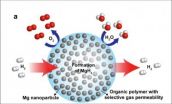(Press-News.org) UPTON, NY - Scientists from the U.S. Department of Energy's (DOE) Brookhaven National Laboratory, Stony Brook University, and collaborators have demonstrated the efficacy of a "wearable," portable PET scanner they've developed for rats. The device will give neuroscientists a new tool for simultaneously studying brain function and behavior in fully awake, moving animals.
The researchers describe the tool and validation studies in the April 2011 issue of Nature Methods.
"Positron emission tomography (PET) is a powerful tool for studying the molecular processes that occur in the brain," said Paul Vaska, head of PET physics at Brookhaven with a joint appointment at Stony Brook, who led the development of the portable scanner together with Brookhaven colleagues David Schlyer and Craig Woody. PET studies in animals at Brookhaven and elsewhere have helped to uncover the molecular underpinnings of conditions such as drug addiction.
But studying animals with PET has required general anesthesia or other methods to immobilize the animals. "Immobilization and anesthesia make it impossible to simultaneously study neurochemistry and the animals' behavior - the actions resulting from what goes on in the brain," Schlyer said. "Our approach was to eliminate the need for restraint by developing a PET scanner that would move with the animal, thus opening up the possibility of directly correlating the imaging data with behavioral data acquired at the same time."
After several years of development, the scientists have arrived at a design for a miniature, portable, donut-shaped PET scanner that can be "worn" like a collar on a rat's head for simultaneous studies of brain function and behavior. Weighing only 250 grams, the device - dubbed RatCAP, for Rat Conscious Animal PET - is counterbalanced by a system of springs and motion stabilizers to allow the animal significant freedom of movement. Measurements of the rats' stress hormones indicated only moderate and temporary increases.
"Rats wearing the device appear to adapt well and move freely about their environment," Woody said.
To validate the use of the wearable scanner for simultaneous studies of brain function and behavior, the scientists conducted tests with 11C-raclopride, a commonly used PET radiotracer, which incorporates a radioactive, positron-emitting isotope of the element carbon. When the positrons interact with electrons in ordinary matter, they immediately annihilate one another, emitting back-to-back gamma rays. Detectors in the circular PET scanner pick up the signals from these back-to-back gamma rays to identify the location and concentration of the tracer in the body.
The tracer 11C-raclopride binds to receptors for dopamine, a brain chemical involved in movement, reward, and memory formation. A higher signal from the tracer means that less natural dopamine is in that particular part of the brain; a low signal indicates that that particular part of the brain has released dopamine (which binds to its receptors, thus blocking the tracer from binding).
The main test was to see if the wearable scanner could be used to correlate dopamine levels with behavior - in this case, the rats' activity (i.e., movement) within their chambers. Surprisingly the level of activity was inversely related to dopamine levels - that is, the more active the animals were, the lower the level of dopamine (as indicated by a stronger tracer signal).
"This is perhaps a counterintuitive result because behavioral activation is typically associated with an increase in dopamine release," said Daniela Schulz, a Brookhaven behavioral neuroscientist and lead author of the paper. "So our method provides data which may challenge traditional paradigms and ultimately improve our understanding of the dopamine system."
"But regardless of the direction, the results clearly demonstrate that RatCAP can correlate brain function measurements with behavioral measures in a useful way," she said.
The scientists also present results comparing RatCAP-wearing rats moving freely about their cages with animals that had been anesthetized, as well as comparisons of two methods of administering the tracer - injecting it all at once and in a steady infusion to maintain a constant concentration in the blood.
"These measurements will help us further refine the technique and aid in our assessment of results obtained with RatCAP in comparison with other study techniques," Schulz said.
The researchers' next step will be to use RatCAP to explore distinct behavioral expressions that can be correlated with simultaneously acquired PET data.
The research was funded by the DOE Office of Science. Development of RatCAP was a joint effort between Brookhaven's Medical, Chemistry and Physics Departments, Instrumentation Division and the Biomedical Engineering Department at Stony Brook University. Co-authors on the paper include: Daniela Schulz (Brookhaven), Sudeepti Southekal (Brigham & Women's Hospital, Boston),Sachin S. Junnarkar (Brookhaven), Jean-François Pratte (Université de Sherbrooke, Sherbrooke, Canada), Martin L. Purschke (Brookhaven), Paul O'Connor (Brookhaven), Sean P. Stoll (Brookhaven), Bosky Ravindranath (Stony Brook), Sri Harsha Maramraju (Stony Brook), Srilalan Krishnamoorthy (Stony Brook), Fritz A. Henn (Brookhaven and Cold Spring Harbor Laboratory), Craig L. Woody (Brookhaven), and David J. Schlyer and Paul Vaska (Brookhaven and Stony Brook).
All research involving laboratory animals at Brookhaven National Laboratory is conducted under the jurisdiction of the Lab's Institutional Animal Care and Use Committee (IACUC, http://www.bnl.gov/ora/IACUC.asp) in compliance with the Public Heath Service (PHS) Policy on Humane Care and Use of Laboratory Animals (http://grants.nih.gov/grants/olaw/references/phspol.htm), the U.S. Department of Agriculture's Animal Welfare Act (http://www.nal.usda.gov/awic/legislat/usdaleg1.htm), and the National Academy of Sciences' Guide for the Care and Use of Laboratory Animals (http://www.nap.edu/readingroom/books/labrats/). This research has enhanced understanding of a wide array of human medical conditions including cancer, drug addiction, Alzheimer's and Parkinson's diseases, and normal aging and has led to the development of several promising treatment strategies.
One of ten national laboratories overseen and primarily funded by the Office of Science of the U.S. Department of Energy (DOE), Brookhaven National Laboratory conducts research in the physical, biomedical, and environmental sciences, as well as in energy technologies and national security. Brookhaven Lab also builds and operates major scientific facilities available to university, industry and government researchers. Brookhaven is operated and managed for DOE's Office of Science by Brookhaven Science Associates, a limited-liability company founded by the Research Foundation of State University of New York on behalf of Stony Brook University, the largest academic user of Laboratory facilities, and Battelle, a nonprofit, applied science and technology organization.
Visit Brookhaven Lab's electronic newsroom for links, news archives, graphics, and more at http://www.bnl.gov/newsroom , or follow Brookhaven Lab on Twitter, http://twitter.com/BrookhavenLab .
### END
Miniature 'wearable' PET scanner ready for use
New tool will allow integrated, simultaneous study of behavior and brain function in animals
2011-03-13
ELSE PRESS RELEASES FROM THIS DATE:
Stena Line Predicts 100% Increase in Indian Tourists to Mainland Europe
2011-03-13
Stena Line, one of the world's largest ferry operators, has announced it is predicting a 100 per cent increase in Indian passengers in 2011 on its twice daily ferry service between Harwich and the Hook of Holland.
Some 10,000 Indian tourists travelled the route between Harwich and the Hook of Holland in 2010 and 20,000 are expected to travel it in 2011 as Indians holidaying in Europe are trying to avoid the Air Passenger Duty (APD) costs that would be incurred if they chose to fly back home from the UK.
India is in the APD band C which means that the tax has doubled ...
Untapped crop data from Africa predicts corn peril if temperatures rise
2011-03-13
A hidden trove of historical crop yield data from Africa shows that corn – long believed to tolerate hot temperatures – is a likely victim of global warming.
Stanford agricultural scientist David Lobell and researchers at the International Maize and Wheat Improvement Center (CIMMYT) report in the inaugural issue of Nature Climate Change next week that a clear negative effect of warming on maize – or corn – production was evident in experimental crop trial data conducted in Africa by the organization and its partners from 1999 to 2007.
Led by Lobell, the researchers ...
Bupa Reveals the Average Brit is Cutting Life Expectancy by 12 Years
2011-03-13
Bupa has revealed that the average Brit is at risk of cutting more than a decade off their life through unhealthy lifestyle habits. This is according to new research from the leading international healthcare group.
The Bupa study assessed lifestyle behaviours such as smoking, alcohol intake, diet and exercise as well as other factors, in nearly 5,000 adults across Britain to calculate the nation's average Health Age, which is the impact that lifestyles are having on Briton's life expectancy.
The results showed that on average, Brits have a Health Age 12 years older ...
Consortium finds chronic liver cirrhosis clues
2011-03-13
Researchers have provided new clues into the genetics underlying a chronic form of liver disease, called primary biliary cirrhosis, which can lead to transplant surgery for patients. The new study identifies 15 genetic regions that affect a person's risk of developing the disease, more than trebling the number of known genetic regions, which now stands at 22.
The study was based on the genomes of 2,500 patients with primary biliary cirrhosis and more than 7,500 apparently healthy people. The results are the first to emerge from the Wellcome Trust Case Control Consortium ...
'Good cholesterol' structure identified, could help explain protective effects
2011-03-13
CINCINNATI—University of Cincinnati (UC) researchers have determined the structure of human HDL cholesterol and say the finding could help explain how this "fat packet" protects against cardiovascular diseases, including heart attack and stroke.
The study, led by W. Sean Davidson, PhD, professor in UC's pathology and laboratory medicine department, appears online ahead of print March 13, 2011, in the journal Nature Structural & Molecular Biology.
HDL (high-density lipoproteins) also known as "good cholesterol," are packets of protein and fat that deliver fat to specific ...
Combination overcomes breast cancer resistance to herceptin
2011-03-13
HOUSTON - Breast cancer tumors take numerous paths to resist the targeted drug Herceptin, but a single roadblock at a crucial crossroads may restore a tumor's vulnerability to treatment, scientists at The University of Texas MD Anderson Cancer Center report on line at Nature Medicine.
Adding the drug saracatinib to Herceptin treatment shrinks previously resistant tumors by cutting off at least five different molecular pathways, each of which can resist, said senior author Dihua Yu, M.D., Ph.D., professor in MD Anderson's Department of Molecular and Cellular Oncology.
"Scientists ...
Bigmouthmedia Expands Analytics Services with Nedstat Professional Accreditation
2011-03-13
Bigmouthmedia has expanded the range of analytics services on offer to clients after announcing that the agency has been awarded global professional accreditation status by Nedstat.
Underlining bigmouthmedia's expertise in web analytics, two members of its team recently passed Nedstat's prestigious Sitestat professional exam qualifications. The accreditation, which will allow the agency to work as a Sitestat Authorized Partner, represents the latest step in the company's strategy to expand and diversify the range of services on offer to clients.
"This is a significant ...
With new method, CSHL team is able to infer how tumors evolve and spread
2011-03-13
Cold Spring Harbor, NY -- A new method of analyzing cancerous tumors developed by scientists at Cold Spring Harbor Laboratory (CSHL) suggests that tumors may not evolve gradually, but rather in punctuated or staccato-like bursts. It is a finding that has already shed new light on the process of tumor growth and metastasis, and may help in the development of new methods to clinically evaluate tumors.
The new analytic method, devised by CSHL Professor Michael Wigler and colleagues, features a process called single cell sequencing (SNS), which enables accurate quantification ...
Berkeley Lab scientists achieve breakthrough in nanocomposite for high-capacity hydrogen storage
2011-03-13
Since the 1970s, hydrogen has been touted as a promising alternative to fossil fuels due to its clean combustion —unlike hydrocarbon-based fuels, which spew greenhouse gases and harmful pollutants, hydrogen's only combustion by-product is water. Compared to gasoline, hydrogen is lightweight, can provide a higher energy density and is readily available. But there's a reason we're not already living in a hydrogen economy: to replace gasoline as a fuel, hydrogen must be safely and densely stored, yet easily accessed. Limited by materials unable to leap these conflicting ...
Key Assets Presents New Career Opportunities in Fostering
2011-03-13
Key Assets, a 'not for profit' non-government fostering agency operating in South Australia, is providing carers with the opportunity to commit to fostering on a full-time basis with 24-hour support and a rewarding fostering fee. This will enable carers to commit the time and attention that this fulfilling career deserves.
Working in partnership with the Department for Families and Communities, Key Assets provides foster care placements for a wide range of children and young people across South Australia. Through the delivery of Team Parenting, an approach based upon ...
LAST 30 PRESS RELEASES:
CHANGE-seq-BE finds off-target changes in the genome from base editors
The Journal of Nuclear Medicine Ahead-of-Print Tip Sheet: January 2, 2026
Delayed or absent first dose of measles, mumps, and rubella vaccination
Trends in US preterm birth rates by household income and race and ethnicity
Study identifies potential biomarker linked to progression and brain inflammation in multiple sclerosis
Many mothers in Norway do not show up for postnatal check-ups
Researchers want to find out why quick clay is so unstable
Superradiant spins show teamwork at the quantum scale
Cleveland Clinic Research links tumor bacteria to immunotherapy resistance in head and neck cancer
First Editorial of 2026: Resisting AI slop
Joint ground- and space-based observations reveal Saturn-mass rogue planet
Inheritable genetic variant offers protection against blood cancer risk and progression
Pigs settled Pacific islands alongside early human voyagers
A Coral reef’s daily pulse reshapes microbes in surrounding waters
EAST Tokamak experiments exceed plasma density limit, offering new approach to fusion ignition
Groundbreaking discovery reveals Africa’s oldest cremation pyre and complex ritual practices
First breathing ‘lung-on-chip’ developed using genetically identical cells
How people moved pigs across the Pacific
Interaction of climate change and human activity and its impact on plant diversity in Qinghai-Tibet plateau
From addressing uncertainty to national strategy: an interpretation of Professor Lim Siong Guan’s views
Clinical trials on AI language model use in digestive healthcare
Scientists improve robotic visual–inertial trajectory localization accuracy using cross-modal interaction and selection techniques
Correlation between cancer cachexia and immune-related adverse events in HCC
Human adipose tissue: a new source for functional organoids
Metro lines double as freight highways during off-peak hours, Beijing study shows
Biomedical functions and applications of nanomaterials in tumor diagnosis and treatment: perspectives from ophthalmic oncology
3D imaging unveils how passivation improves perovskite solar cell performance
Enriching framework Al sites in 8-membered rings of Cu-SSZ-39 zeolite to enhance low-temperature ammonia selective catalytic reduction performance
AI-powered RNA drug development: a new frontier in therapeutics
Decoupling the HOR enhancement on PtRu: Dynamically matching interfacial water to reaction coordinates
[Press-News.org] Miniature 'wearable' PET scanner ready for useNew tool will allow integrated, simultaneous study of behavior and brain function in animals



